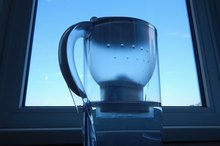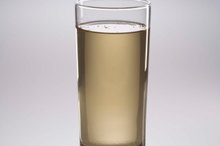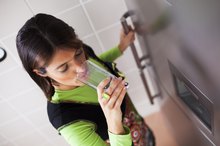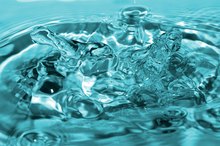Why Shouldn't You Drink the Water Following a Water Main Break?
Water main breaks occur often, typically due to accidental breakage during digging, freezing weather conditions that create stress or weakened pipes, and older infrastructure breaking down, according to the New York City Office of Emergency Management. In addition to causing street or property flooding, a break in a water main creates potentially unsafe drinking water both during the break and for a short time after repairs fix the break.
During
Water treatment plants work to provide water containing safe levels of contaminations. Traveling from the plant to your home, the water remains relatively unchanged — picking up some materials in the pipes due to aging materials and joints, but still meeting water quality guidelines for consumption. When a water main breaks, debris from the broken pipes and surrounding area may flow into the pipes and water. Often the water department cuts off water flow; however, if you suspect an area water main break, report it and stop using water until notified it is safe.
- Water treatment plants work to provide water containing safe levels of contaminations.
- Traveling from the plant to your home, the water remains relatively unchanged — picking up some materials in the pipes due to aging materials and joints, but still meeting water quality guidelines for consumption.
After
Disadvantages of Water Filters
Learn More
After completing the repairs to the main water pipes, the water often continues to have contamination. Those responsible for the water continue to check for leaks and monitor the water for contamination while flushing the pipes. Until tests show no more danger of breaks and contamination, warnings not to drink water from the tap continue.
Contaminants
Water main breaks result in more than dirt and discoloration in your tap water. Your water may contain dangerous contamination even if it looks clear. Some problems found in water following water main breaks include microbial contaminants, pathogens capable of causing disease outbreaks and gastroenteritis disorders, unsafe chemicals and E coli, according to the U.S. Environmental Protection Agency 2. Dangers of Legionella spp. and other gram-negative bacteria also increase with water main breaks and repairs, according to the Centers for Disease Control and Prevention.
- Water main breaks result in more than dirt and discoloration in your tap water.
- Some problems found in water following water main breaks include microbial contaminants, pathogens capable of causing disease outbreaks and gastroenteritis disorders, unsafe chemicals and E coli, according to the U.S. Environmental Protection Agency 2.
Tap
Sore Throat After Swimming in a Lake
Learn More
Your local agencies notify the public about steps needed for using water. Generally, the public notice recommends boiling the water at a roiling boil for at least one minute. The types of contamination may make the water undrinkable even if boiled if the water contains certain chemicals or metals. Follow the instructions given, purchase bottled water or obtain water from people not located in the affected area. Once the water testing indicates a safe level, some contamination may continue in your home's pipes. To help clear up the water in your house, allow the water to flow through all of your taps to help flush out contaminated water and pipes. Run water softeners, water purifiers and any water storage tanks through a cycle to remove contaminated water before using.
- Your local agencies notify the public about steps needed for using water.
- Run water softeners, water purifiers and any water storage tanks through a cycle to remove contaminated water before using.
Related Articles
References
- Centers for Disease Control: Healthcare Water System Repair Following Disruption of Water Supply
- U.S. Environmental Protection Agency: New or Repaired Water Mains
- Ohashi Y, Sakai K, Hase H, Joki N. Dry weight targeting: The art and science of conventional hemodialysis. Semin Dial. 2018;31(6):551-556. doi:10.1111/sdi.12721
- Beverages, water, tap, drinking. FoodData Central. U.S. Department of Agriculture. Published April 1, 2019.
- Dietary reference intakes for water, potassium, sodium, chloride, and sulfate. National Academies Press, 2005.
- Jéquier E, Constant F. Water as an essential nutrient: The physiological basis of hydration. Eur J Clin Nutr. 2010;64(2):115-23. doi:10.1038/ejcn.2009.111
- Popkin BM, D'Anci KE, Rosenberg IH. Water, hydration, and health. Nutr Rev. 2010;68(8):439-4358. doi:10.1111/j.1753-4887.2010.00304.x
- Adan A. Cognitive performance and dehydration. J Am Coll Nutr. 2012;31(2):71-8. doi:10.1080/07315724.2012.10720011
- Dennis EA, Dengo AL, Comber DL, et al. Water consumption increases weight loss during a hypocaloric diet intervention in middle-aged and older adults. Obesity (Silver Spring). 2010;18(2):300-307. doi:10.1038/oby.2009.235
- National Institutes of Health Genetic and Rare Diseases Information Center. Aquagenic urticaria. Updated June 20, 2016.
- Centers for Disease Control and Prevention. Well testing. Updated April 10, 2009.
Writer Bio
Daniel Cobalt lives in Georgia and has been writing online for over five years. He has a technical certificate in printing from the Philadelphia Printing School. His areas of expertise include fitness, home schooling, parenting, personal relationships, small business ownership and pet topics including breeding, training and responsible ownership.









